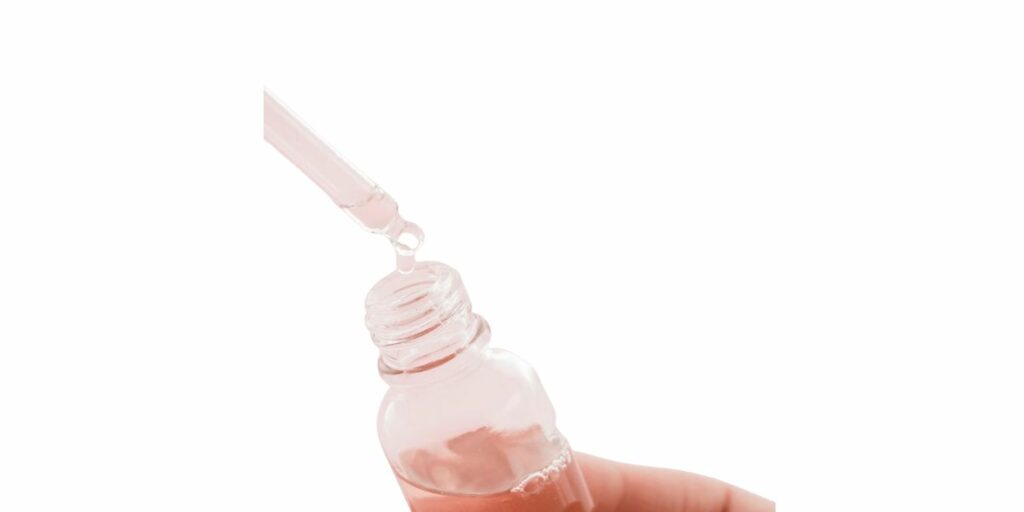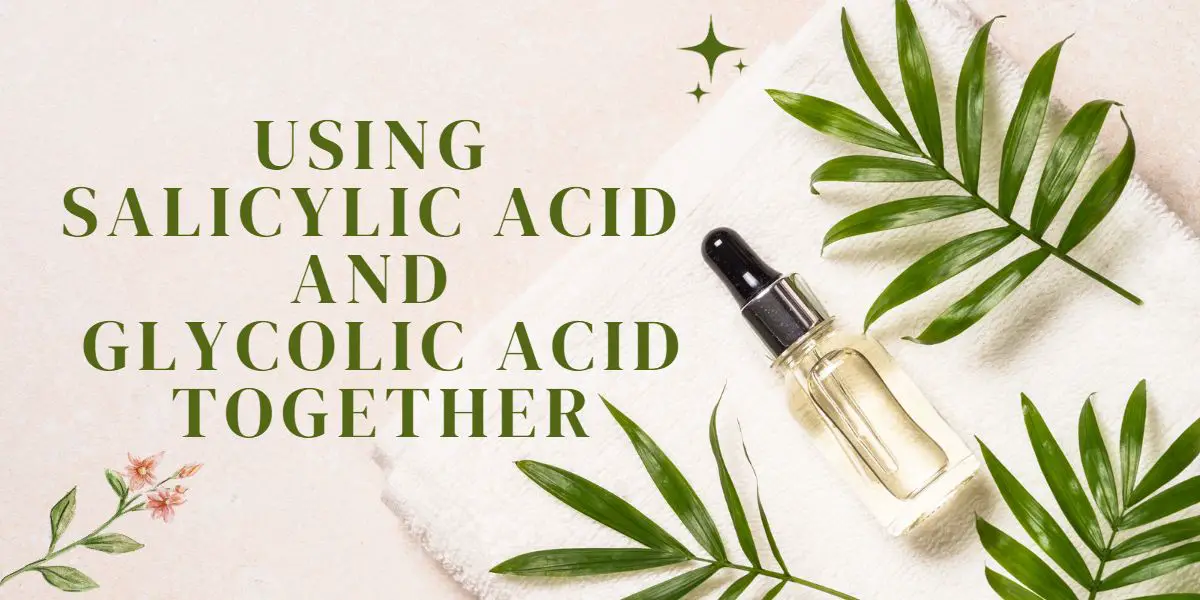Using Salicylic Acid and Glycolic Acid Together
Jump To:
If you’re looking to achieve smoother, clearer skin, you may have considered using exfoliating acids like salicylic acid and glycolic acids. These two alpha hydroxy acids (AHAs) have the ability to gently slough away dead skin cells and reveal brighter, more radiant skin. But can these two acids be used together, and if so, how?
In this blog, we’ll dive into the world of acid layering and show you how to incorporate glycolic and salicylic acid into your beauty routine for maximum benefits. From understanding the differences between these two AHAs to learning the proper application techniques, you’ll discover the key to achieving smoother, healthier-looking skin through the use of glycolic and salicylic acid.
Salicylic acid
Salicylic acid is a type of alpha hydroxy acid (AHA) that is derived from willow bark. It is commonly used in skincare products for its exfoliating and acne-fighting properties. Salicylic acid works by breaking down the bonds between dead skin cells, allowing them to be shed more easily. This helps to unclog pores and prevent acne breakouts. Salicylic acid is also anti-inflammatory, which can help to reduce redness and swelling associated with acne.
Salicylic acid is usually found in a concentration of 0.5% to 2% in over-the-counter beauty products, and higher concentrations may be prescribed by a dermatologist. It is usually found in products such as cleansers, toners, spot treatments, and peel pads. Salicylic acid is typically safe for most skin types. Those with sensitive skin may want to start with a lower concentration and gradually increase as tolerated. It is important to follow the recommended usage and application guidelines for any salicylic acid product to avoid potential irritation or dryness.
Glycolic acid
Glycolic acid is a type of alpha hydroxy acid (AHA) that is derived from sugarcane. This ingredient is one of the commonly used ingredients in beauty products for its exfoliating and skin-brightening properties. It helps to improve the overall texture and tone of the skin. It also reduces the appearance of fine lines and wrinkles. Various research shows that glycolic acid helps to initiate collagen synthesis. It has the ability to improve the penetration of other skincare products, making it a popular ingredient in many serums and moisturizers.
Glycolic acid is usually found in a concentration of 5% to 20% in over-the-counter products, and higher concentrations may be prescribed by a dermatologist. It is usually present in products such as cleansers, toners, serums, and peel pads. It is generally suitable for all skin types. Those with sensitive skin may want to start with a lower concentration and gradually increase as tolerated. It is important to follow the recommended usage and application guidelines for any glycolic acid product to avoid potential irritation or dryness. In addition, it is important to use sunscreen, as it can increase sun sensitivity.
Salicylic and Glycolic Acid: What is the difference?
Both glycolic and salicylic acids are alpha hydroxy acids (AHAs), which have exfoliating properties. However, there are some differences between the two ingredients:

- Source: Salicylic acid is derived from willow bark, while glycolic acid is derived from sugarcane.
- Structure: Salicylic acid is a beta hydroxy acid (BHA), which means it has a larger, oil-soluble molecule that is able to penetrate the pores and exfoliate inside and out. Glycolic acid is an AHA, which means it has a smaller, water-soluble molecule that exfoliates the surface of the skin.
- Function: Both glycolic and salicylic acid exfoliate the skin by removing dead skin cells, but they can have different target areas and skin concerns. Salicylic acid is best for unclogging pores and treating acne, while glycolic acid is better for improving the overall texture and tone of the skin.
- Strength: pH level and concentration determine the strength of an acid product. Salicylic acid products tend to have a lower pH and higher concentration, while glycolic acid products have a higher pH and lower concentration.
In general, salicylic acid is better for oily, acne-prone skin, while glycolic acid is more suitable for dry, aging skin. However, both acids can be beneficial for a wide range of skin concerns and types, and it is important to choose the right product and concentration for your individual needs.
Salicylic vs glycolic: Which is the best acid serum for your skin?
Both glycolic and salicylic acid can be beneficial for the skin, but which one is the best for you will depend on your individual skin concerns and type.
Here are a few factors to consider when choosing an acid serum:
- Skin type: Different acid serums are suitable for different skin types. For example, salicylic acid is typically for oily, acne-prone skin, while glycolic acid is usually better for dry, aging skin. However, both acids can be beneficial for a wide range of skin concerns and types, and it is important to choose a product that is appropriate for your skin.
- Skin concerns: Consider what specific concerns you have about your skin, such as acne, uneven skin tone, or fine lines and wrinkles. Different acid serums target specific concerns, so choose a product that addresses your specific needs.
- Strength: pH level and concentration determine the strength of an acid product. If you have sensitive skin, it is usually best to start with a lower concentration and gradually increase as tolerated. If you are using multiple acid serums, it is usually best to start with the product that has the lower concentration or pH level and work your way up.
- Ingredients: In addition to the acid, consider the other ingredients in the product. Choose a product with beneficial ingredients such as antioxidants, moisturizing agents, and skin-repairing ingredients.
If you are unsure which acid is best for you, it is always a good idea to consult with a dermatologist or skin care professional for personalized recommendations.
Can You Use these acids Together?
It is generally safe combining glycolic and salicylic acid, but generally shouldn’t be used together. However, acid effectively works alone. Make sure to follow the proper application techniques. Here are a few tips for using these two acids together:
- Start with a lower concentration. If you are using multiple acid serums, it is usually best to start with the product that has the lower concentration or pH level and work your way up. This can help to prevent irritation or dryness.
- Use separate products for each acid. Instead of mixing the two acids together, consider using a separate product for each acid. This can help to prevent potential irritation or adverse reactions.
- Follow the instructions on the product packaging. Each acid serum is different, and it is important to follow the recommended usage and application guidelines.
- Use a moisturizer after applying acid serums. Acids can sometimes cause dryness or sensitivity, so it is important to follow up with a moisturizer to hydrate and protect the skin.
How to layer acid serums in your skin care routine
Layering glycolic and salicylic acid in your skincare routine can provide a range of benefits for your skin, but it is important to do so safely and correctly to avoid potential irritation or adverse reactions.
You can certainly use glycolic acid and salicylic acid together. Here are a few tips you must consider:
- Cleanse and dry your face.
- Apply lower concentration or pH level acid serums first.
- Target specific skin concerns with separate acid serums.
- Follow product instructions for usage and application.
- Moisturize after applying acid serums.
It is important to exercise caution when using acid serums, especially if you have sensitive skin. If you are unsure about which products or concentrations to use, it is a good idea to consult with a dermatologist or skin care professional for personalized recommendations. This can help to ensure that you are using the right skin care acids and techniques to safely and effectively incorporate acids into your skincare routine.
Do’s and Don’ts of layering acid serum

Do’s:
- Start with a clean, dry face. Make sure to remove all makeup and cleanse your skin before applying any acid serums.
- Follow the instructions on the product packaging. Each acid serum is different, and it is important to follow the recommended usage and application guidelines.
- Use a lower concentration or pH level product first. If you are using multiple acid serums, it is usually best to start with a lower concentration or pH level and work your way up.
- Use a separate acid serum for each area of concern. If you have multiple skin concerns, consider using a separate acid serum for each area to target the specific concern.
- Always use a moisturizer after applying acid serums. Acids can sometimes cause dryness or sensitivity, so it is important to follow up with a moisturizer to hydrate and protect the skin.
Don’ts:
- Don’t use acid serums too often. It is usually best to start with a couple of times per week and gradually increase as tolerated. Overuse of acid serums can lead to irritation and dryness.
- Do not mix different acid serums together. While it may be tempting to mix and match, it is best to use each acid on its own. This will avoid potential irritation or adverse reactions.
- Don’t use acid serums if you have sensitive skin. If you have sensitive skin, it is important to be cautious when using acid serums. Consult a dermatologist or skin care professional before starting a new product.
- Do not forget to use sunscreen. Acid serums can increase sun sensitivity, so it is important to use a broad-spectrum sunscreen with an
Layering acid serum: Wrapping up
Incorporating glycolic and salicylic acid into your skincare routine can provide a range of benefits for your skin. From unclogging pores and treating acne to improving texture and tone, these two alpha hydroxy acids can be powerful tools in your beauty arsenal.
However, it is important to use them correctly. Choose the right products and concentrations for your individual skin concerns and type. By following the proper application techniques and starting with lower concentrations and gradually increasing as tolerated, you can safely and effectively layer glycolic and salicylic acid to achieve smoother healthier-looking skin.
